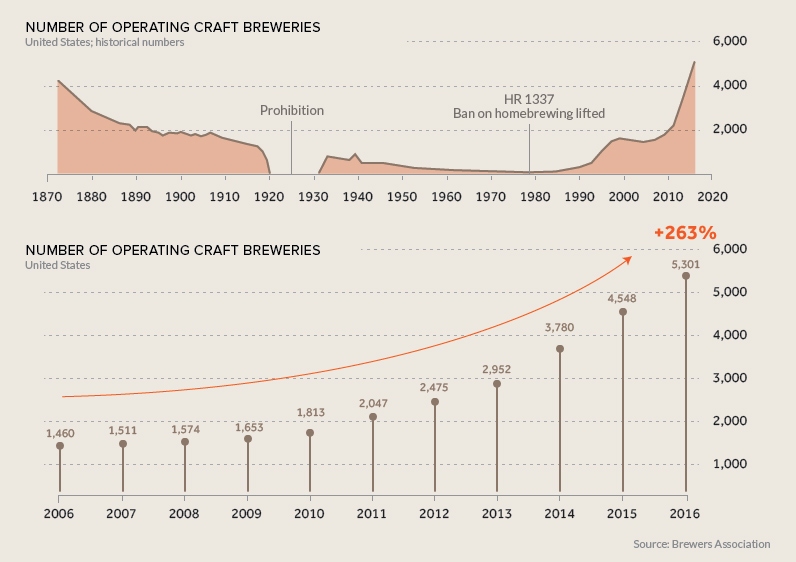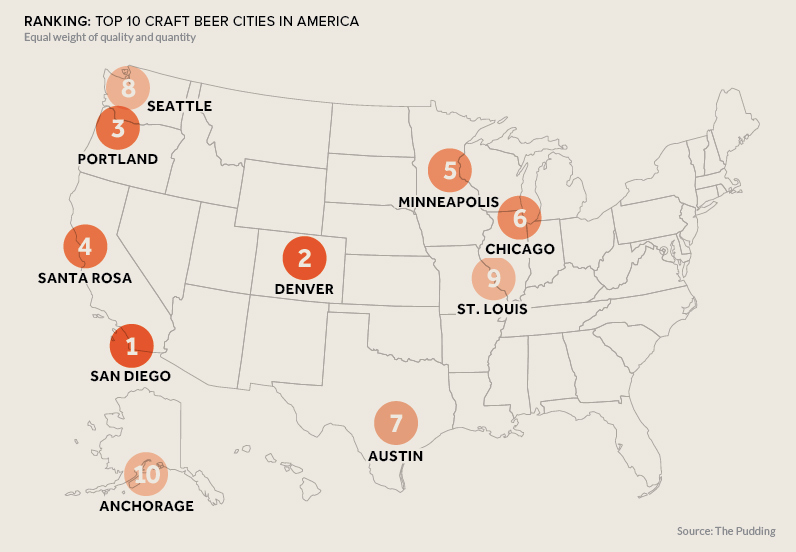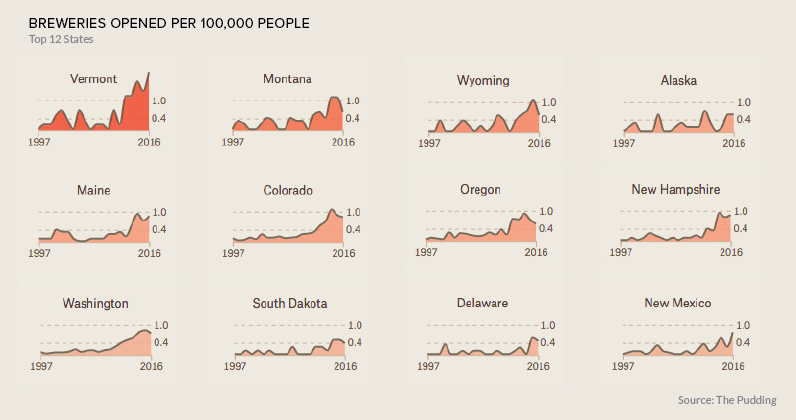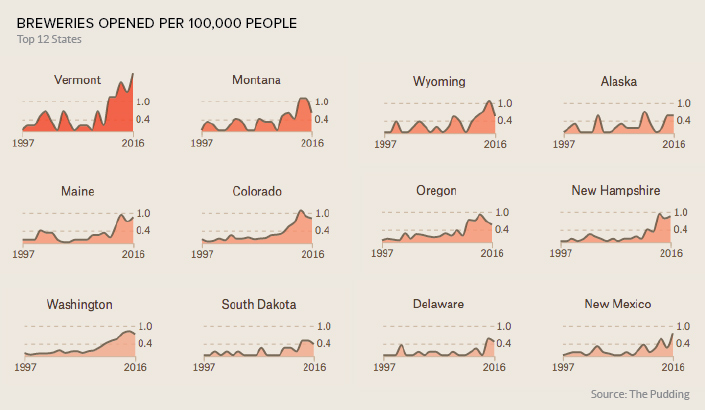With an economic impact of $23.5 billion and the number of operating breweries in the U.S. totaling well over 5,000 today, the industry is clearly past the point of being a millennial fad. There are more choices available than ever before, and this appears to signal a broader shift in consumer preference. Below is a look at both historical and recent craft beer industry numbers:
Mapping Craft Beer Hubs
The craft beer boom is a nation-wide trend, but there are certain cities that have an outsize influence on the industry both in volume and reputation. Recently, The Pudding’s Russell Goldenberg looked to answer the question: which city is the microbrew capital of the U.S.? Goldenberg looks at both quality of beer (based on user ratings), as well as the quantity of nearby breweries as criteria. Below are the Top 10 cities based on equal weights for both categories, with an end result that may be unexpected for some.
Extremely high user ratings helped power mid-sized cities like Santa Rosa and Anchorage up the rankings. The offerings in these places, such as Russian River Brewing and Midnight Sun Brewing Company, are among the top rated brewers in the country, setting a high bar for quality. However, in terms of the pure quantity of breweries, cities like Denver, Portland, and San Diego can’t be beat. The Denver “Beer Triangle” has over 72 breweries alone, while Portland is a regular destination for beer lovers from all over the continent.
New Breweries Per Capita
Looking at the state level, per capita data paints an interesting picture of where craft beer hot spots are beginning to emerge: Browse the full list here. Most notably, Vermont is wild about craft beer, though their industry is more uniformly spread throughout the state (as opposed to clustered in a single city). A recent count shows 68 active breweries in a state with just 625,000 in population – a very impressive beer-to-drinker ratio.
Bubble Brewing?
Will the craft beer boom continue, or is there already too much froth in some cities? Currently, 75% of Americans live within 10 miles of a brewery, but there are still plenty of population centers that could support a local brewery. Savvy marketing, unique offerings, and millennial preferences for local products may continue to push the craft brew trend into new parts of the country, so this will be an interesting list to revisit in a few years.
on Even while political regimes across these countries have changed over time, they’ve largely followed a few different types of governance. Today, every country can ultimately be classified into just nine broad forms of government systems. This map by Truman Du uses information from Wikipedia to map the government systems that rule the world today.
Countries By Type of Government
It’s important to note that this map charts government systems according to each country’s legal framework. Many countries have constitutions stating their de jure or legally recognized system of government, but their de facto or realized form of governance may be quite different. Here is a list of the stated government system of UN member states and observers as of January 2023: Let’s take a closer look at some of these systems.
Monarchies
Brought back into the spotlight after the death of Queen Elizabeth II of England in September 2022, this form of government has a single ruler. They carry titles from king and queen to sultan or emperor, and their government systems can be further divided into three modern types: constitutional, semi-constitutional, and absolute. A constitutional monarchy sees the monarch act as head of state within the parameters of a constitution, giving them little to no real power. For example, King Charles III is the head of 15 Commonwealth nations including Canada and Australia. However, each has their own head of government. On the other hand, a semi-constitutional monarchy lets the monarch or ruling royal family retain substantial political powers, as is the case in Jordan and Morocco. However, their monarchs still rule the country according to a democratic constitution and in concert with other institutions. Finally, an absolute monarchy is most like the monarchies of old, where the ruler has full power over governance, with modern examples including Saudi Arabia and Vatican City.
Republics
Unlike monarchies, the people hold the power in a republic government system, directly electing representatives to form government. Again, there are multiple types of modern republic governments: presidential, semi-presidential, and parliamentary. The presidential republic could be considered a direct progression from monarchies. This system has a strong and independent chief executive with extensive powers when it comes to domestic affairs and foreign policy. An example of this is the United States, where the President is both the head of state and the head of government. In a semi-presidential republic, the president is the head of state and has some executive powers that are independent of the legislature. However, the prime minister (or chancellor or equivalent title) is the head of government, responsible to the legislature along with the cabinet. Russia is a classic example of this type of government. The last type of republic system is parliamentary. In this system, the president is a figurehead, while the head of government holds real power and is validated by and accountable to the parliament. This type of system can be seen in Germany, Italy, and India and is akin to constitutional monarchies. It’s also important to point out that some parliamentary republic systems operate slightly differently. For example in South Africa, the president is both the head of state and government, but is elected directly by the legislature. This leaves them (and their ministries) potentially subject to parliamentary confidence.
One-Party State
Many of the systems above involve multiple political parties vying to rule and govern their respective countries. In a one-party state, also called a single-party state or single-party system, only one political party has the right to form government. All other political parties are either outlawed or only allowed limited participation in elections. In this system, a country’s head of state and head of government can be executive or ceremonial but political power is constitutionally linked to a single political movement. China is the most well-known example of this government system, with the General Secretary of the Communist Party of China ruling as the de facto leader since 1989.
Provisional
The final form of government is a provisional government formed as an interim or transitional government. In this system, an emergency governmental body is created to manage political transitions after the collapse of a government, or when a new state is formed. Often these evolve into fully constitutionalized systems, but sometimes they hold power for longer than expected. Some examples of countries that are considered provisional include Libya, Burkina Faso, and Chad.



















